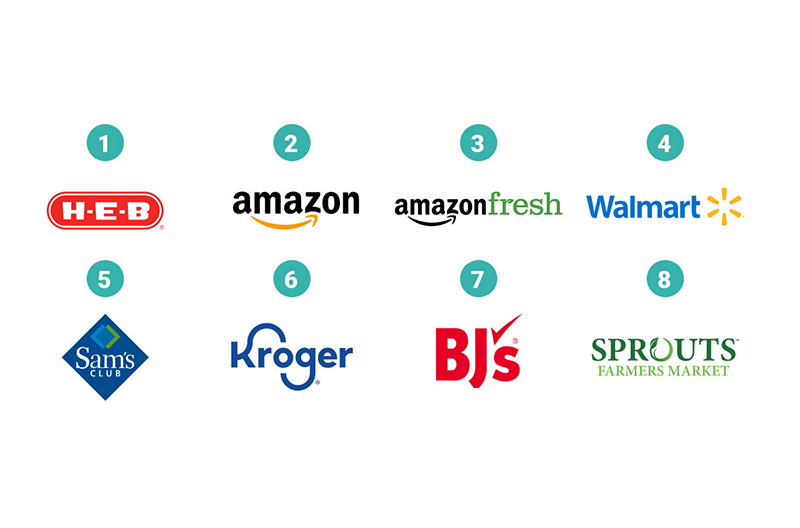Dunnhumby has released its first “E-Commerce Retailer Preference Index,” a nationwide study that examines the emerging $100 billion U.S. e-commerce grocery market. In a near statistical tie, San Antonio, Texas-based H-E-B narrowly edged out Amazon and Amazon Fresh as the top ranked e-commerce grocer.
Walmart landed in the fourth spot and Sam’s Club rounded out the top five. Kroger, BJ’s and Sprouts had the next highest scores in the RPI.
The dunnhumby e-commerce RPI was released June 28 as part of The Dunnhumby Quarterly: a new market analysis of key retail themes, with the first edition being focused on e-commerce.
“H-E-B’s impressive performance proves that it’s possible to compete and win against Amazon when it comes to grocery e-commerce. Their success offers mid-size and regional retailers a roadmap on how to succeed online,” said Grant Steadman, president of North America for dunnhumby.
“H-E-B’s e-commerce journey goes back to 2015, when they first started with curbside pick-up, and they have since built up a powerful online ecosystem. The combination of a simple and easy to use shopping experience with a fantastic emotional connection with customers shows how grocers can thrive in this multichannel landscape.”
The overall RPI rankings are the result of a consumer survey-informed statistical model that predicts how retailers execute on the customer needs that matter most for driving e-commerce performance and emotional bonds with online shoppers.
Key findings from the study:
- H-E-B captured the top ranking in this inaugural study due to a number of factors, including having the highest level of emotional connection and online share of wallet among their customer base. Although they were relatively new to offering online shopping, H-E-B customers were the ones that migrated their spending online the most after the pandemic hit, increasing their grocery spending online by 27 percent, which resulted in H-E-B having the highest share of wallet online.
- The eight top performing retailers in this study all have well-established e-commerce capabilities, and most of them also have scale and size as a key competitive advantage. In addition, first tercile retailers have a clear strength in their own digital assets, versus relying mostly on intermediaries, having achieved a higher adoption with three out of five customers shopping on these assets during their last online trip.
- Unlike the dunnhumby U.S. Grocery RPI that ranks prices as the most important customer preference driver, for e-commerce success the most important drivers are 1) owned digital asset usage and 2) ease and reliability. Walmart, Amazon and Amazon Fresh are the three top ranked retailers for owned digital asset usage. Sam’s Club, Amazon Fresh and Aldi are the top three retailers for ease and reliability.
- Omnichannel shoppers look very different than brick and mortar shoppers. Omnichannel shoppers, which can be up to 40 percent of all shoppers, are defined as customers who purchase with a retailer across multiple channels. Thirty-eight percent are between the ages of 25-54 and have at least two children. They buy online two times per month with three out of every five visits to a retailer grocer occurring online. On average, they spend $531 per month across all the stores they shop and spend $131 per month – 25 percent of their share of wallet – with a single retailer.
- In contrast, brick and mortar only shopper is at least 50 percent of a retailer’s shopping base. Fifty-seven percent of them are 55 and up, and are either empty nesters, retirees or both. On average, these shoppers spend $382 per month across all the stores they shop and spend $111 per month – 29 percent of their share of wallet – with a single retailer.
- Covid accelerated grocery growth for e-commerce, but it may have just brought the grocery sector closer to its e-commerce sales ceiling at a faster rate, rather than raised the height of that ceiling. Rising inflation, a subsiding pandemic, and increased consumer mobility are putting the brakes on e-commerce growth.
The full RPI report can be downloaded here.
For more Southwest news from The Shelby Report, click here.

